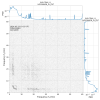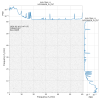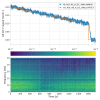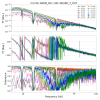The squeezers performed some optimization of the squeezing today (76426), and we have our New DARM control implemented (76420). The calibration has been updated (76406), so I think we have a reliable look at our current sensitivity. Our current range is just above 150 Mpc, going between 151 and 156 on the sensmon range. This is lower than our best O4a range. However, looking at a comparison from a good O4a time, you can see pretty well where we are missing sensitivity.
I have attached three plots, comparing the CAL_DELTAL_EXTERNAL trace that is calibrated and with no cal lines on from today, to GDS CALIB STRAIN NOLINES and CLEAN taken on Jan 7 when we had close to 160 Mpc. I made a plot each to compare DELTAL/NOLINES and DELTAL/CLEAN and all three together, so the differences are more evident.
Clearly the low frequency range has a big improvement, which I think is mostly attributable to the new DARM. It's also much more stationary (76341). Great work! There is an unfortunate peaky structure around 25-30 Hz; this was present in O4a too and I think we are just revealing more of it with the improvement. There's a chance these are triple suspension bounce modes (70778). There appears to be some extra peaks and noise between 40-50 Hz.
The jitter noise appears to have gotten worse around 100 Hz, and this is especially evident in the GDS CLEAN comparison because a large portion of what is subtracted in CLEAN during O4a was jitter noise. It is now worse and also unsubtracted at the moment. Also, it appears we have lost some sensitivity from 200-500 Hz, which I think we can attribute to squeezing not being exactly tuned for that region.
Meanwhile, the squeezing improvements are incredibly significant at 2 kHz and above, where the squeezing team says they are reaching 5 dB of squeezing! This is fantastic, but given the loss at 300 Hz, I wonder if it's possible to optimize for the bucket (just making this suggestion based on what I've heard from the sqz team in the past).
Some additional notes for further commissioning work:
- we have found an AS A WFS DC offset that minimizes DHARD Y coupling, but creates a problem for the sqz ASC. We should evaluate whether the squeeze team can work around this, because it will likely help the low frequency sensitivity but not the squeezing. (76407)
- With the low frequency improvement, we are probably reaching the level of the ASC noise again. It is unlikely loop optimization will help us further, so adjustments like A2L gains and WFS offsets are a good way to go to improve sensitivity (76363, 76414)
- The LSC noise is more likely to limit us, and we may need a better understanding of where we are limited by LSC noise if our feedforward tuning cannot improve at all frequencies (76409)
- We should consider if changing the input pointing can lower the jitter noise. This will probably be a pain because this will change the alignment of the whole IFO (76359, 76417)


























































Actually both PIT and YAW see coherence with DARM, so maybe this is worth some more thinking. The PZT injection is very visible in yaw, but not much in pitch